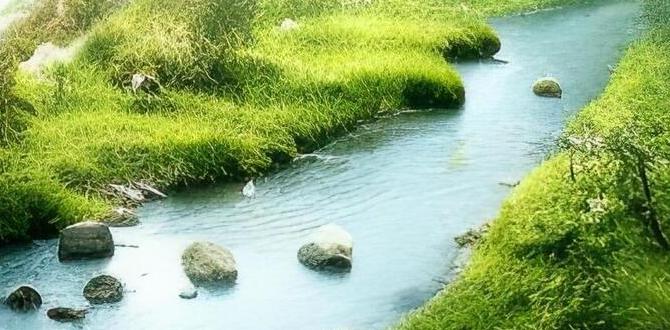Looking for the best Austria sunrise & sunset photo spots? This guide reveals Austria’s most breathtaking locations for capturing stunning morning and evening light, perfect for photographers of all levels, from the Alps to cityscapes.
Capturing the magic of a sunrise or sunset can transform a great travel photo into an unforgettable one. In Austria, with its dramatic mountain landscapes, charming villages, and historical cities, the opportunities are endless. But finding those perfect vantage points can sometimes feel like a treasure hunt, especially for those new to travel photography or visiting for the first time. Don’t worry, this guide is here to help! We’ll walk you through some of the most stunning, accessible, and picture-perfect spots across Austria to catch the golden hour. Get ready to fill your camera roll with moments of pure beauty.
Austria Sunrise & Sunset Photo Spots: Your Essential Guide
Austria is a land where the mountains meet the sky, and the light paints the landscape in hues of gold and rose. Whether you’re an avid photographer aiming for that award-winning shot or just someone who appreciates a beautiful view, timing your visit to these locations for sunrise or sunset will undoubtedly elevate your experience. We’ve curated a list of top spots, catering to different preferences, from serene alpine vistas to vibrant city panoramas. Let’s dive into where to find Austria’s most spectacular light.
The Majestic Alps: Sunrise & Sunset Heaven
The Austrian Alps are not just for skiing or hiking; they are also incredible backdrops for dawn and dusk. The interplay of light with the rugged peaks and lush valleys creates dramatic, awe-inspiring scenes. These spots often require a bit of planning, perhaps an early start or a late return, but the payoff is immense.
1. Hallstatt, Upper Austria: A Fairytale Sunrise
Hallstatt is arguably one of Austria’s most picturesque villages, nestled between a crystal-clear lake and towering mountains. For sunrise, the classic viewpoint from the southern end of the village, near the cemetery, offers a postcard-perfect shot of the wooden houses, the lake, and the Dachstein mountain range emerging from the mist. The soft morning light illuminates the facades and the tranquil water beautifully. Aim to be there well before sunrise to find your spot and witness the gradual illumination.
Why it’s great for sunrise:
- Calm lake reflects the village and mountains.
- Soft, diffused light is ideal for capturing detail.
- The “magic hour” glow enhances the fairytale atmosphere.
Sunset tip: While sunrise is more famous, a walk along the lake promenade as dusk settles can offer lovely light on the colourful buildings and the opposite shore, with the mountains sil houetted against the fading sky.
2. Grossglockner High Alpine Road: Peaks Aglow
Driving the Grossglockner High Alpine Road, especially during the golden hours, is an experience in itself. There are numerous viewpoints along this scenic route, but for sunrise, consider pulling over at one of the higher passes. As the sun crests the horizon, it bathes the Grossglockner, Austria’s highest peak, and the surrounding glaciers in a warm, golden light. Sunset offers a similar spectacle, with the mountains glowing in fiery oranges and reds as the sun dips behind the peaks.
Essential tips for the Grossglockner:
- Check road opening times, as it’s seasonal (typically early May to late October).
- Dress warmly; it’s significantly colder at higher altitudes.
- Bring a sturdy tripod for sharp, long-exposure shots and to combat lower light conditions.
You can find more information about the Grossglockner High Alpine Road, including opening times and visitor information, on their official website: Grossglockner High Alpine Road.
3. Alpspitzbahn, Tyrol: Above the Clouds
For a truly dramatic perspective, head to the Alpspitzbahn in the nearby Zugspitze Arena. Taking one of the cable cars up (check their operating hours carefully for sunrise potential) can place you high above the valleys. At dawn, you might find yourself above a layer of clouds, with the emerging sun painting the peaks around you. This provides a surreal and unique photographic opportunity. Sunset here offers similar breathtaking views as the last light kisses the highest summits.
Key considerations:
- Confirm the operating hours of the cable car. Early risers might need to consider hiking if the lifts aren’t running.
- Weather can change rapidly; always be prepared with appropriate gear.
4. Schafberg Mountain, Salzkammergut: Panoramic Perfection
Accessible by a charming cogwheel railway from St. Wolfgang, Schafberg Mountain offers one of the most commanding panoramic views in Austria. For sunrise, the sight of the sun rising over the chain of lakes (Wolfgangsee, Mondsee, Attersee) with the Alps in the background is simply unforgettable. The gentle light is perfect for capturing sweeping landscapes. Sunsets from Schafberg are equally spectacular, offering a fiery farewell to the day over this serene lake district.
Traveler’s tip: Book your cogwheel railway tickets in advance, especially during peak season, and inquire about any special early morning or late evening services for photography purposes.
City Lights & Reflections: Urban Sunrise & Sunset Spots
Austria’s cities offer a different, yet equally captivating, canvas for photographers. The blend of historical architecture, modern life, and waterways creates unique opportunities to capture the golden hour. These spots are generally more accessible, often requiring less specialized gear than mountain photography.
5. The Old Danube (Alte Donau), Vienna: City Skyline Glow
For a stunning city sunset or sunrise, head to the Old Danube in Vienna. This expansive body of water is perfect for capturing reflections of the city skyline, including the iconic Ferris wheel in the Prater amusement park, as the sky turns vibrant shades. A quiet spot along the waterfront, particularly on a calm evening, will provide a serene setting for photography. Sunrise offers a softer light, illuminating the city as it wakes up.
Photographic advantages:
- Excellent reflections on still water.
- Iconic Viennese landmarks in the background.
- Accessible by public transport.
6. Pöstlingberg, Linz: A Bird’s-Eye View
If you’re visiting Linz, the Pöstlingberg offers a fantastic panoramic view over the city and the Danube. The Pöstlingbergbahn, one of Europe’s steepest adhesion railways, takes you to the summit. At sunset, the city lights begin to twinkle below as the sky glows, creating a magical scene. Sunrise can also be rewarding, though ensure the railway is operating early enough for your desired timing.
What to expect:
- Wide-ranging views of Linz and the surrounding landscape.
- Charming church and cafes at the summit.
- A peaceful escape from the city bustle.
7. Salzburg’s Hohensalzburg Fortress: Historic Grandeur
The fortress itself offers incredible views, but finding a good vantage point for sunrise or sunset of the fortress can be magical. Try the Mönchsberg or Kapuzinerberg hills opposite the fortress. As the sun rises, it can illuminate the fortress walls in a warm glow. For sunset, find a western-facing spot on the Mönchsberg, overlooking the city with the fortress as a dominant feature, silhouetted or bathed in the dying light.
Tips for Salzburg:
- Mönchsberg is easily accessible via lift or stairs and offers multiple viewpoints.
- Consider the time of year; winter light can be particularly soft and dramatic.
Lakes & Rivers: Serene Light Scenes
Austria’s lakes and rivers provide tranquil settings for capturing the soft, reflective beauty of sunrise and sunset. These locations often offer a sense of peace and allow for stunning mirror-like images.
8. Lake Wolfgangsee: Golden Reflections
Beyond Schafberg, the shores of Lake Wolfgangsee themselves are fantastic for sunrise and sunset photography. Towns like St. Wolfgang, Strobl, and Abersee offer accessible waterfront spots. Watching the sun rise over the eastern mountains or set behind the western peaks, casting vibrant colours onto the lake’s surface, is truly special. The steam rising from the water on cooler mornings can add an ethereal quality.
Why it’s a great choice:
- Ample public access points along the shore.
- Iconic Salzkammergut scenery.
- Opportunities for boat-based photography for unique perspectives.
9. The Wachau Valley: Vineyards in Golden Light
This UNESCO World Heritage site along the Danube River is famous for its vineyards, apricot orchards, and charming medieval towns. For sunrise, find a spot on the northern bank looking east as the sun rises behind the rolling hills, casting long shadows across the vineyards. Sunset is equally stunning, with the golden light illuminating the vines and the river. Look for vantage points near Melk Abbey or Dürnstein.
Wachau Valley highlights:
- Unique landscape of terraced vineyards.
- Historical castles and abbeys provide dramatic foregrounds or backgrounds.
- The river adds a reflective element.
For information on the Wachau Valley, you can visit the official tourism site: Wachau Valley Tourism.
Practical Tips for Capturing the Perfect Shot
To make the most of your sunrise and sunset photography adventures in Austria, a little preparation goes a long way. These tips will help ensure you’re comfortable, safe, and ready to capture those fleeting moments of beauty.
1. Check the Weather and Sunrise/Sunset Times
This is critical! Use reliable weather apps and websites that provide exact sunrise and sunset times for your specific location. Austrian weather, especially in the Alps, can be unpredictable. Always have a backup plan.
- Websites: Time and Date provides detailed astronomical information for exact locations.
- Apps: Many photography-specific apps offer sunrise/sunset data, moon phases, and even sun path predictions.
2. Gear Up for Comfort and Safety
Outdoor photography, particularly in the early morning or late evening, requires some essential gear beyond your camera.
- Clothing: Dress in layers. Even in summer, mountain air can be cool. A waterproof and windproof outer layer is advisable. Warm socks and comfortable, sturdy footwear are a must, especially for uneven terrain.
- Light Sources: A headlamp or flashlight is essential for navigating in the dark before sunrise or after sunset, especially if walking on trails. Consider one with a red light setting to preserve your night vision and avoid disturbing wildlife or other photographers.
- Tripod: For low-light situations, a tripod is invaluable for sharp images. Choose a lightweight but sturdy model that is easy to set up.
- Camera Bag: A comfortable backpack for carrying your gear, snacks, water, and extra clothing.
- Extras: Spare batteries (cold drains them faster), memory cards, lens cleaning cloth.
For travel, especially with family, comfort is paramount. If you’re traveling with children or require personal care items for longer journeys, consider packing essentials like adult diapers or child diapers discreetly packed in your luggage. This ensures peace of mind and allows everyone to focus on the experience, whether it’s catching a sunrise in the Alps or exploring a historic city.
3. Timing is Everything: Arrive Early, Stay Late
The “golden hour” is a short period, but the light changes dramatically. Plan to arrive at your chosen spot at least 30-45 minutes before the official sunrise or sunset time. This gives you time to set up, scout compositions, and capture the pre-sunrise glow or the post-sunset afterglow, which can often be as beautiful as the main event.
4. Scout Your Location (If Possible)
If you have the chance, visit your chosen spot during daylight hours. This helps you identify the best angles, potential foreground elements, and safe pathways. Knowing the terrain beforehand will make your pre-dawn or post-dusk excursion much smoother and safer.
5. Respect Nature and Local Rules
When visiting natural areas or historical sites, always adhere to local regulations. Stay on marked paths, do not disturb wildlife or vegetation, and pack out everything you pack in. Many of these stunning locations are protected to preserve their beauty for future generations.
Sunrise vs. Sunset: Which is Better for Photos?
Both sunrise and sunset offer incredible photographic opportunities, but they have distinct characteristics:
| Timing | Light Quality | Atmosphere | Crowds | Typical Subjects |
|---|---|---|---|---|
| Sunrise | Soft, diffused, cool tones that warm up as the sun rises. Often creates a gentle, ethereal glow. Mist or fog is common. | Peaceful, quiet, a sense of a new beginning. | Generally fewer people, especially at less accessible locations. | Landscapes, cityscapes waking up, portraits with soft light. |
| Sunset | Warm, intense, golden to fiery red tones. Denser atmosphere can lead to more dramatic colours. Longer shadows. | Often more dramatic, energetic, and a sense of ending. | Can be more crowded, especially at popular viewpoints. | Silhouettes, landscapes bathed in warm light, city lights appearing. |
For a beginner, both are excellent. Sunrise might offer more tranquility and unique misty conditions, while sunset often provides more vibrant, saturated colours and a lively atmosphere.
Essential Photography Gear for Golden Hour
While you can take great photos with just your smartphone, a few key pieces of gear can significantly enhance your results, especially in challenging light conditions.
- Camera: A DSLR, mirrorless, or even a high-quality smartphone camera will work.
- Lenses:
- Wide-angle lens: For capturing sweeping landscapes and expansive views.
- Telephoto lens: Useful for isolating mountain peaks or compressing the scene.
- Tripod: As mentioned, crucial for stability and sharpness in low light.
- Remote Shutter Release (Optional): Helps prevent camera shake when using a tripod for long exposures.
- Filters (Optional):
- Polarizing filter: Can deepen colours and reduce glare on water.
- Neutral Density (ND) Graduated filter: Helps balance the exposure between a bright sky and a darker foreground.
- Extra Batteries: Low temperatures can quickly drain batteries.
- Memory Cards: Always have a spare.
Don’t let complex gear intimidate you. Start with what you have and gradually build your kit as you grow more comfortable and passionate about capturing these beautiful moments.
Frequently Asked Questions (FAQ)
Q1: What is the best time of year for sunrise and sunset photos in Austria?
The best time depends on the location and desired effect. Spring (April-May) and Autumn (September-October) often provide lovely colours in the landscape and fewer crowds. Winter offers dramatic snowy scenes but requires more careful preparation for cold and shorter daylight hours. Summer can have great light, but haze or cloud cover can sometimes reduce visibility.
Q2: Do I need a special permit to photograph at these locations?
Generally, for personal photography, no special permits are required at most public viewpoints, national parks, or city streets. However, if you plan to use professional lighting, drones, or conduct commercial shoots, permits might be necessary. Always check with local authorities or park management if you are unsure.
Q3: How can I get good reflections in my photos?
Calm water is key! Lakes, slow-moving rivers, and even puddles after rain can create excellent reflections. Shoot during the “blue hour” (just before sunrise or after sunset) for softer, more diffused light that isn’t too harsh on the reflections. Sometimes, very early morning before any wind picks up is your best bet for still water.
Q4: What if the weather is bad on the day I plan to shoot?
Don’t be discouraged! Dramatic skies often come with challenging weather. Moody clouds, fog, and rain can create very atmospheric and unique photos. If it’s truly unsafe or visibility is zero (e.g., heavy snowstorm in the mountains), you might need to reschedule, but often, even a slightly overcast day can yield beautiful, soft light.
Q5: Are these locations accessible for beginners or families?
We’ve tried to include a mix. Hallstatt, Vienna’s Danube, and Salzburg’s fortress areas are very accessible. Mountain locations like Gross





